Hi All
After the postive comments about our thread of assisting a Macaw to hatch I thought I'd start a similar thread documenting the incubation of our Rheas.
https://www.backyardchickens.com/forum/viewtopic.php?id=472294
We bought 4 eggs in 2010 from three different sources and decided to use our experience of parrots and poultry incubation and apply these principles to the Rheas.
We dicovered the Rheas should be incubated a degree lower than our other eggs so we had use our only spare incubator and pirate a Brinsea Octogon 20. First problem was the eggs were to big and we could'nt fit the hood on
 We cut out a collar from a dense styrofoam that went round the edge and raised the height internally by 3 inches. The hood was placed on the base with a little clearence for the top of the eggs. This was held on by wrapping a velcro strap round the whole incubator to hold it as a snug fit when turning. The 4 eggs filled the incubator and the automatic turning mechanism did some groaning with the weight of the eggs (approx 3 kilos). So the eggs were set at 36.4C with no water in the incubator and RH 40%. They were turned throughout by that little Brinsea turning motor and a daily hand turn of 180 degrees. So with everything set up we left the eggs to it and waited. I'll let the pictures complete the story.
We cut out a collar from a dense styrofoam that went round the edge and raised the height internally by 3 inches. The hood was placed on the base with a little clearence for the top of the eggs. This was held on by wrapping a velcro strap round the whole incubator to hold it as a snug fit when turning. The 4 eggs filled the incubator and the automatic turning mechanism did some groaning with the weight of the eggs (approx 3 kilos). So the eggs were set at 36.4C with no water in the incubator and RH 40%. They were turned throughout by that little Brinsea turning motor and a daily hand turn of 180 degrees. So with everything set up we left the eggs to it and waited. I'll let the pictures complete the story.
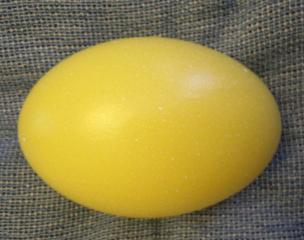
The Rheas eggs are an olive colour when fresh but soon fade to cream.
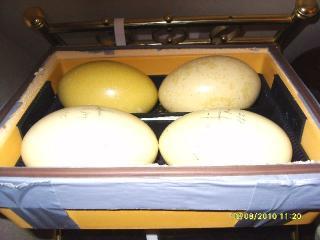
The Brinsea Octogon 20 fully loaded and with a 'height booster'.
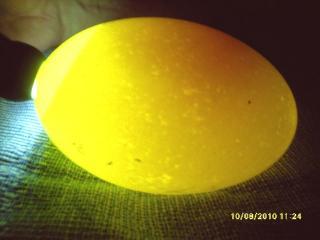
Candling a fresh Rhea egg.
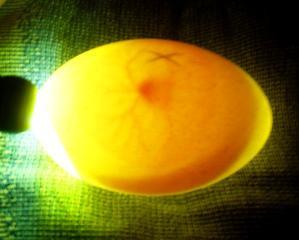
Candling at Day 8/9 and the baby Rhea is visible.
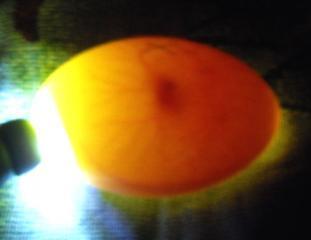
Candling on Day 11
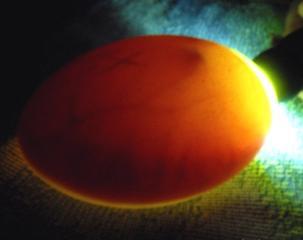
Candling on Day 14
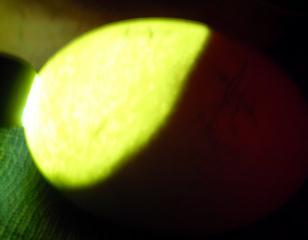
Day 30 and sudden air cell enlargement which drops down one side of the egg
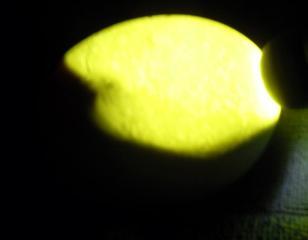
Day 31 and the air cell now has shadows moving into it as the chick positions its head for internal pipping.
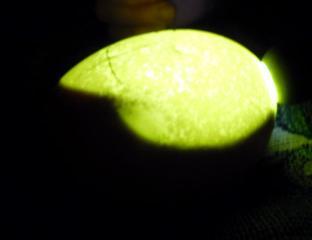
Day 32
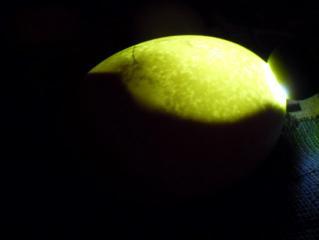
Day 33 The shadows are clearer and the darker shadow in the air cell is the beak. We could hear clicking and an occasional whistle to confirm internal pipping.
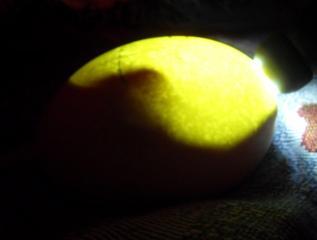
Day 34. The shadow of the bill in the large air cell is even clearer. All eggs hatching normally appear like this on candling once internally pipped. The egg automatically rolls with the pip uppermost if placed on a flat surface. This is the natural hatching position!
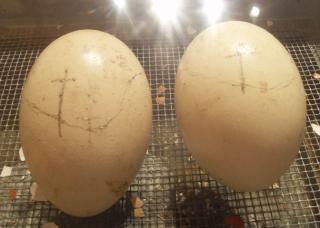
Day 35 and now in a still air incubator with raised humidity - 'Lockdown'. Note the large size of the air cells that I traced in pencil onto the shells when candling.

Day 36. No zipping they just burst out after smashing large chunks of shell off. 1 other egg in lockdown with them and 1 still in the Brinsea.

Number 3 required assistance with internally pipping. The egg was resealed with surgical tape once respiration commenced.
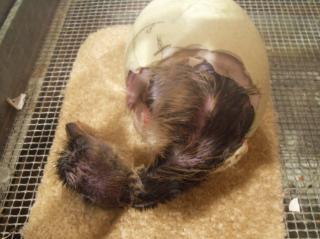
36 hours later and the baby's ready to hatch. Guided by candling and behaviour we knew when to safely realease the tape to allow hatching. Its a Grey!!!
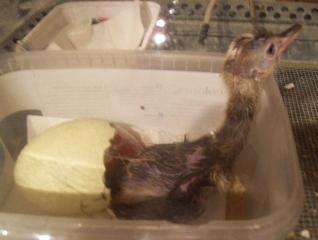
Hello world!!!
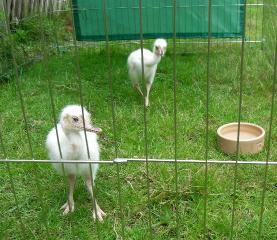
The first 2 that hatched were Whites. At 2 days old we started putting them in an outdoor pen for a few hours.
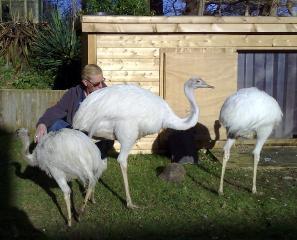
The gang of juvenile Rheas March 2011.
In all we hatched and raised all 4 eggs. We got 3 whites and 1 grey. We think we've got one white male and the rest are female. They've got very inquisitive personalities and pull at our watches, rings etc. They're still growing but doing well on graze and ostrich growers pellets. Hope you enjoyed the story and found it interesting

Pete
After the postive comments about our thread of assisting a Macaw to hatch I thought I'd start a similar thread documenting the incubation of our Rheas.
https://www.backyardchickens.com/forum/viewtopic.php?id=472294
We bought 4 eggs in 2010 from three different sources and decided to use our experience of parrots and poultry incubation and apply these principles to the Rheas.
We dicovered the Rheas should be incubated a degree lower than our other eggs so we had use our only spare incubator and pirate a Brinsea Octogon 20. First problem was the eggs were to big and we could'nt fit the hood on


The Rheas eggs are an olive colour when fresh but soon fade to cream.

The Brinsea Octogon 20 fully loaded and with a 'height booster'.

Candling a fresh Rhea egg.

Candling at Day 8/9 and the baby Rhea is visible.

Candling on Day 11

Candling on Day 14

Day 30 and sudden air cell enlargement which drops down one side of the egg

Day 31 and the air cell now has shadows moving into it as the chick positions its head for internal pipping.

Day 32

Day 33 The shadows are clearer and the darker shadow in the air cell is the beak. We could hear clicking and an occasional whistle to confirm internal pipping.

Day 34. The shadow of the bill in the large air cell is even clearer. All eggs hatching normally appear like this on candling once internally pipped. The egg automatically rolls with the pip uppermost if placed on a flat surface. This is the natural hatching position!

Day 35 and now in a still air incubator with raised humidity - 'Lockdown'. Note the large size of the air cells that I traced in pencil onto the shells when candling.

Day 36. No zipping they just burst out after smashing large chunks of shell off. 1 other egg in lockdown with them and 1 still in the Brinsea.

Number 3 required assistance with internally pipping. The egg was resealed with surgical tape once respiration commenced.

36 hours later and the baby's ready to hatch. Guided by candling and behaviour we knew when to safely realease the tape to allow hatching. Its a Grey!!!

Hello world!!!

The first 2 that hatched were Whites. At 2 days old we started putting them in an outdoor pen for a few hours.

The gang of juvenile Rheas March 2011.
In all we hatched and raised all 4 eggs. We got 3 whites and 1 grey. We think we've got one white male and the rest are female. They've got very inquisitive personalities and pull at our watches, rings etc. They're still growing but doing well on graze and ostrich growers pellets. Hope you enjoyed the story and found it interesting

Pete
Last edited:





